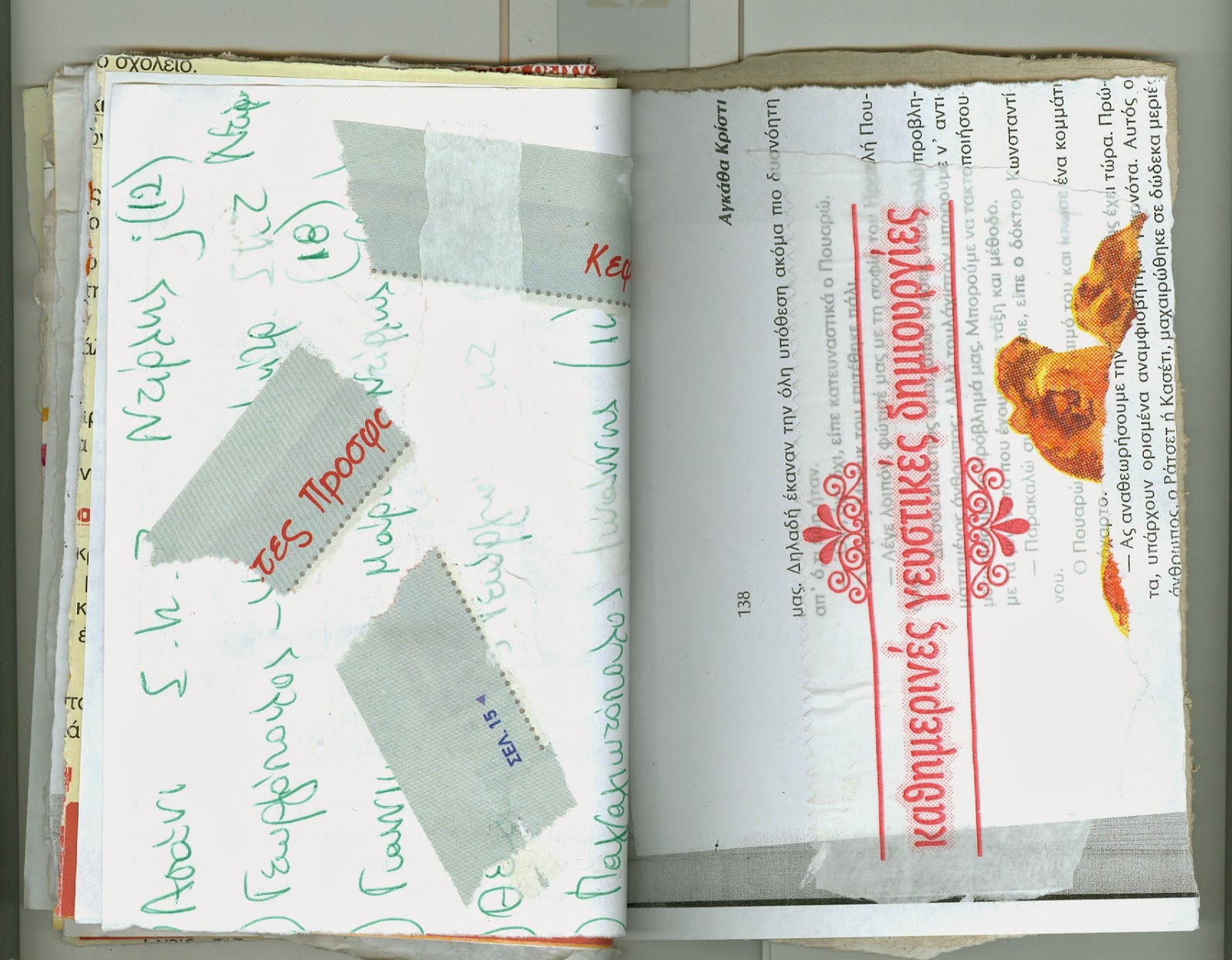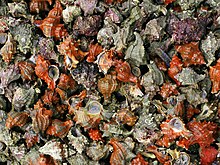This is my first trashbook, sent to Diane Keys for All Things Trashpo
http://iuoma-network.ning.com/group/all-things-trashpoSEND MAIL ART TO...

Mail Art project “ Altered book pages” You are invited to participate in a Mail Art project entitled “Altered book pages”. You may paint, make a collage, use photos and more on a book page. You can use any kind of book pages you want and as many pages you want or an entire book. If you like I can send you some pages from Greek books to use. Theme: Altered book pages Size, media, number of submissions: Free No fees, no jury, no returns. Deadline: May 1st 2017 Please include the title of the work, your name, address, email address, etc. Documentation: All entries will be displayed online so if you don’t want your contact details (postal and email address) to be published please let me know. A venue is currently being sought where the works can be Exhibited. Details of this will be made available later. Send your mail art to: DIMITRA PAPATHEODOROU P.O. Box 3019 23 Zaimi street 26110 Patra GREECE … Thankyou!!!
Τρίτη 10 Ιουνίου 2014
Παρασκευή 6 Ιουνίου 2014
Muricidae
From Wikipedia, the free encyclopedia
Muricidae is the name of a large and varied taxonomic family of small to large predatory sea snails, marine gastropod mollusks, commonly known as murex snails or rock snails. With about 1,600 living species, the Muricidae represent almost 10% of the Neogastropoda. Additionally, 1,200 fossil species have been recognized.[1] Numerous subfamilies are recognized, although experts disagree about the subfamily divisions and about defining the genera. Many muricids have unusual shells which are considered attractive by shell collectors and by interior designers.
Many muricids have episodic growth, which means their shells grow in spurts, remaining the same size for a while (during which time the varix develops) before rapidly growing to the next size stage. The result is the series of above mentioned varices on each whorl.

Muricids lay eggs in protective, corneous capsules the size and shape of which vary with the species. From these capsules the crawling juveniles, or more rarely planktonic larvae, hatch.
Muricidae is the name of a large and varied taxonomic family of small to large predatory sea snails, marine gastropod mollusks, commonly known as murex snails or rock snails. With about 1,600 living species, the Muricidae represent almost 10% of the Neogastropoda. Additionally, 1,200 fossil species have been recognized.[1] Numerous subfamilies are recognized, although experts disagree about the subfamily divisions and about defining the genera. Many muricids have unusual shells which are considered attractive by shell collectors and by interior designers.
Shell description
Muricid shells are variably shaped, generally with a raised spire and strong sculpture with spiral ridges and often axial varices (typically three or more varices on each whorl), also frequently bearing spines, tubercles or blade-like processes. Periostracum is absent in this family. The aperture is variable in shape; it may be ovate to more or less contracted, with a well-marked anterior siphonal canal that may be very long. The shell's outer lip is often denticulated inside, sometimes with a tooth-like process on its margin. The columella is smoothish to weakly ridged. The operculum is corneous and of variable thickness, with the nucleus near the anterior end or at about midlength of the outer margin.Many muricids have episodic growth, which means their shells grow in spurts, remaining the same size for a while (during which time the varix develops) before rapidly growing to the next size stage. The result is the series of above mentioned varices on each whorl.

A mass of muricid egg capsules in a tidepool in Central California
Life habits
Most species of muricids are carnivorous, active predators that feed on other gastropods, bivalves, and barnacles. The access to the soft parts of the prey is typically obtained by boring a hole through the shell by means of a softening secretion and the scraping action of the radula. Because of their carnivory, some species may be considered pests because they can cause considerable destruction both in exploited natural beds of bivalves, and in farmed areas of commercial bivalves.Muricids lay eggs in protective, corneous capsules the size and shape of which vary with the species. From these capsules the crawling juveniles, or more rarely planktonic larvae, hatch.
Historical value
Members of the genus were harvested by early Mediterranean peoples, with the Phoenicians possibly the first to do so, to extract an expensive, vivid, and stable dye known as imperial, royal or Tyrian purple.The fossil record
The family Muricidae first appears in the fossil record during the Aptian age of the Cretaceous period.Subfamilies
According to the taxonomy of the Gastropoda by Bouchet & Rocroi (2005) the family Muricidae consists of these subfamilies:- Coralliophilinae Chenu, 1859 - synonym: Magilidae Thiele, 1925
- Ergalataxinae Kuroda, Habe & Oyama, 1971
- Haustrinae Tan, 2003
- Muricinae Rafinesque, 1815
- Muricopsinae Radwin & d'Attilio, 1971
- Ocenebrinae Cossmann, 1903
- Rapaninae Gray, 1853 - synonym: Thaididae Jousseaume, 1888
- Tripterotyphinae d'Attilio & Hertz, 1988
- Trophoninae Cossmann, 1903
- Typhinae Cossmann, 1903
Πέμπτη 5 Ιουνίου 2014
Sea shell - Phyllonotus trunculus or Murex trunculus or dye-murex
I’ll try to present some of the
shells in my collection, that I have found where I live, in Patra,
Greece. It is a port in South west Greece.
This shell's name is: Phyllonotus trunculus and I usually find it almost "white" because it is covered with calcium! I like them like this, too and I usually don't clean them.
Some information about this shell:
Murex trunculus (also known as Hexaplex trunculus or banded dye-murex) is a marine snail, whose hypobranchial gland secretes a mucus that the ancient Canaanites/Phoenicians used as a distinctive purple-blue indigo dye. This shell was equally important with brandaris in the ancient purple trade and it was most extensively used by the Phoenicians, but also by the Romans and other Mediterranean cultures.
MUREX SEASHELL:
Family: Muricidae. There are 700 known species in this beautiful family of shells. They are noted for their unique shape and curving spines. The Mollusk is carnivorous and typically feeds on bivalves, shrimp, and sponge that are of similar size. They can be found in sand or mud flats, and on coral reefs. When the frond-like spines are coated with sea moss, the shell may be completely camouflaged amid rocks or on reefs. Interesting Facts: The crimson color of royal purple was created by the Phoenicians by using the Murex Brandaris shell. The rare and brilliant color was used by the emperors of Rome. At that time, the dye cost the equivalent of $10,000 a pound
( information from: https://www.facebook.com/pages/Shell-N-Tings/599732486761007?ref=stream )
This shell's name is: Phyllonotus trunculus and I usually find it almost "white" because it is covered with calcium! I like them like this, too and I usually don't clean them.
Some information about this shell:
Murex trunculus (also known as Hexaplex trunculus or banded dye-murex) is a marine snail, whose hypobranchial gland secretes a mucus that the ancient Canaanites/Phoenicians used as a distinctive purple-blue indigo dye. This shell was equally important with brandaris in the ancient purple trade and it was most extensively used by the Phoenicians, but also by the Romans and other Mediterranean cultures.
MUREX SEASHELL:
Family: Muricidae. There are 700 known species in this beautiful family of shells. They are noted for their unique shape and curving spines. The Mollusk is carnivorous and typically feeds on bivalves, shrimp, and sponge that are of similar size. They can be found in sand or mud flats, and on coral reefs. When the frond-like spines are coated with sea moss, the shell may be completely camouflaged amid rocks or on reefs. Interesting Facts: The crimson color of royal purple was created by the Phoenicians by using the Murex Brandaris shell. The rare and brilliant color was used by the emperors of Rome. At that time, the dye cost the equivalent of $10,000 a pound
( information from: https://www.facebook.com/pages/Shell-N-Tings/599732486761007?ref=stream )
Εγγραφή σε:
Αναρτήσεις (Atom)






























